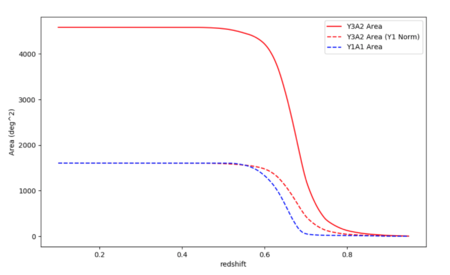Difference between revisions of "January 23, 2019"
(Created page with "= Cluster Correlation Scale = == Overview of RedMaPPer Y3 Data == The RedMaPPer Y3 data is divided into two types of catalog: volume-limited and full. The volume-limited cata...") |
|||
| Line 1: | Line 1: | ||
| + | = Cluster Correlation Scale = | ||
| + | |||
= Cluster Correlation Scale = | = Cluster Correlation Scale = | ||
== Overview of RedMaPPer Y3 Data == | == Overview of RedMaPPer Y3 Data == | ||
The RedMaPPer Y3 data is divided into two types of catalog: volume-limited and full. The volume-limited catalog is limited in redshift as shown in Figure 1. The full catalog does not apply the same redshift limit. For either type, you can then choose between a catalog which include clusters of richness greater than 5, or richness greater than 20. | The RedMaPPer Y3 data is divided into two types of catalog: volume-limited and full. The volume-limited catalog is limited in redshift as shown in Figure 1. The full catalog does not apply the same redshift limit. For either type, you can then choose between a catalog which include clusters of richness greater than 5, or richness greater than 20. | ||
| + | |||
| + | [[File:Volumelimited_rm.png|thumb|left|upright=1.5|alt=Alt text|Plot of sky coverage versus redshift for the RedMaPPer volume-limited cluster catalog. The red line represents Y3 data (and is from a couple iterations ago, but I image that it's not too different from the current iteration.) The blue line represents previous Y1 data and the dashed red line is Y3 data with the norm scaled to Y1, so that you can see that Y3 goes slightly farther out.]] | ||
| + | |||
| + | I am currently using the Volume Limited catalog with lambda > 5. The full catalog contains ~300,000 clusters. The part of the catalog overlapping with the ACT y-map region contains ~80,000 clusters. | ||
| + | |||
| + | == Motivation for Finding the Correlation Scale == | ||
| + | |||
| + | When I plotted all the cluster positions and smoothed them to a four arcminute beam, they were so separated that this did not create the nearly smooth number-density map that we want. Furthermore, if I cut the catalog down into small redshift slices, the clusters are even more sparse. Therefore, I want to know what the optimal scale is to be smoothing on, to create a useful orientation map which will contain relevant information about super-clustering. One way to figure out the best scale is to find the cluster correlation scale: at what distance are clusters most clustered? Another question I have is: what is the ideal distance to slice the cluster sample at? A comoving distance of 30 Mpc? 100? Larger? Examining the cluster correlation function for various slices in redshift will tell us the information on super-clustering scales that we need. | ||
| + | |||
| + | == == | ||
Revision as of 20:59, 22 January 2019
Cluster Correlation Scale
Cluster Correlation Scale
Overview of RedMaPPer Y3 Data
The RedMaPPer Y3 data is divided into two types of catalog: volume-limited and full. The volume-limited catalog is limited in redshift as shown in Figure 1. The full catalog does not apply the same redshift limit. For either type, you can then choose between a catalog which include clusters of richness greater than 5, or richness greater than 20.

I am currently using the Volume Limited catalog with lambda > 5. The full catalog contains ~300,000 clusters. The part of the catalog overlapping with the ACT y-map region contains ~80,000 clusters.
Motivation for Finding the Correlation Scale
When I plotted all the cluster positions and smoothed them to a four arcminute beam, they were so separated that this did not create the nearly smooth number-density map that we want. Furthermore, if I cut the catalog down into small redshift slices, the clusters are even more sparse. Therefore, I want to know what the optimal scale is to be smoothing on, to create a useful orientation map which will contain relevant information about super-clustering. One way to figure out the best scale is to find the cluster correlation scale: at what distance are clusters most clustered? Another question I have is: what is the ideal distance to slice the cluster sample at? A comoving distance of 30 Mpc? 100? Larger? Examining the cluster correlation function for various slices in redshift will tell us the information on super-clustering scales that we need.